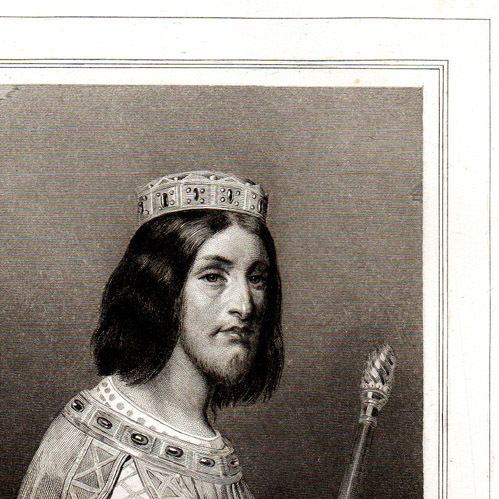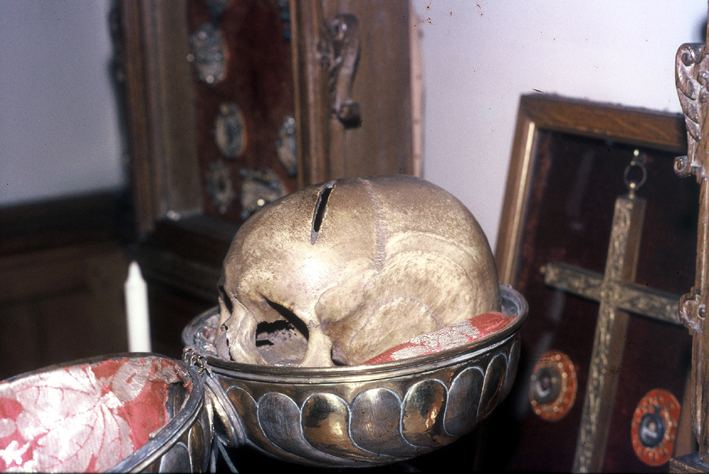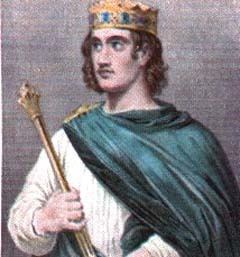Reign 676 – 23 December 679 Parents Sigebert III Name Dagobert II | Successor Theoderic III Grandparents Dagobert I | |
 | ||
Children Saint Adula, Saint Hermine Similar People | ||
Dagobert II
Dagobert II (Latin: Dagobertus; c. 650 – December 23, 679 AD) was the king of Austrasia (676–79), the son of Sigebert III and Chimnechild of Burgundy. He is also accounted a saint by the Roman Catholic Church; his feast day is 23 December.
Contents

Dagobert II
Biography

Dagobert II was born in Metz, the son of Sigibert III, an Austrasian king of the Merovingian line, and his wife, Chimnechild of Burgundy.

The Arnulfing mayor of the Austrasian palace, Grimoald the Elder, the son of Pippin of Landen, and Dagobert's guardian, had had his own son Childebert adopted by Sigebert III, when Sigebert was still childless. Then when Sigebert died in 656, Grimoald seized the throne for his own son and had Dagobert tonsured, thus marking him unfit for kingship, and exiled.

The tale that Dagobert was ordered to be killed and his death published about, but that he was spirited out of the country, seems to be an embellishment, perhaps developed to explain the silence of Dagobert's mother Chimnechild. She may have cooperated with Grimoald to set up Childebert the Adopted; later she hoped by marrying her daughter Bilichild to Childeric II to keep the eventual Austrasian heir in her bloodline. It has been hypothesised that Chimnechild was not Dagobert's mother, thus her reason for abandoning him. It has also been speculated that Childebert was really Sigebert's illegitimate son whom Grimoald adopted to exclude the widow Chimnechild as a rival in the government.
Dagobert was given to the care of Desiderius, Bishop of Poitiers, where there was a cathedral school. The boy was sent on to a monastery in Ireland, sometimes identified as Slane, and later entrusted to Wilfrid of York, who saw to it that he was trained as a page at an Anglo-Saxon court. An old tradition relates that he married Mechthilde, an Anglo-Saxon princess, during his exile, but the tradition that among his daughters was Saint Hermine, abbess of Oëren, and Saint Adula, abbess of Pfalzel, are fabrications, perhaps designed to link the saintly foundresses of these abbeys with the revered Merovingian line.
In the meantime the great nobles of Austrasia appealed to Clovis II, king of Neustria, who expelled the usurpers, executing Grimoald and Childebert, and added Austrasia to his own realm. The dating of these events is greatly confused, they occurred perhaps as early as 657 or as late as 661, under Clotaire III, Clovis' son. The effective ruler however was the Neustrian major domo Ebroin, who was obliged soon thereafter (in 660 or 662) to give the Austrasian realm a king of its own once more: the choice was the child king Childeric II, brother of Clotaire III, with a mayor of the palace, Wulfoald, as regent. The young king was assassinated on a hunt near Maastricht in 675, and in the chaotic power struggle that ensued, the Austrasian magnates, who wanted a king of Merovingian blood, pressed Wulfoald for the return of Dagobert, while opponents of Wulfoald acclaimed one Clovis III, possibly an impostor. Ebroin returned from a monastic "retirement" to lead Clovis' partisans, but Wulfoald effected Dagobert's succession in 676, partly through the help of Wilfrid, Bishop of York, on Clovis' untimely death. In spite of the continuing bitter enmity of Ebroin and the party who had attempted to press Clovis as an alternate candidate, Dagobert was restored to a portion of his rightful lands, a territory along the Rhine, which pious tradition relates that he governed with the mildness and piety his childhood experience had taught him, but which history suggests he left largely to the mayor of the Austrasian palace, while he concerned himself more with the founding of cloisters and abbeys, including Surbourg and Wissembourg in Alsace, where the Duke was his cousin.
The dynamics of Dagobert's career are largely a passive reflection of the competition between two sources of power, patronage and prestige, the palace institutions of Neustria on the one hand, and on the other, of Austrasia, firmly in the control of the Arnulfing dynasty that would become the Carolingians in the following century. In the chaos, the search for a consistent, rational pattern is hard to follow in the shifting loyalties.
During revived conflict between Neustria and Austrasia, Dagobert in his turn was murdered in another hunting incident on December 23, 679, near Stenay-sur-Meuse in the Ardennes, probably on orders from Ebroin, still mayor of the palace in Neustria. Wilfrid must have remained in Austrasia until this time, because, according to his biographer, Wilfrid left Austrasia after the death of Dagobert, in mortal danger from the supporters of Ebroin. At the cloister of Stenay afterwards there grew a cult of Dagobert, venerated as early as 1068 as "Saint Dagobert". The cult spread from there into Lotharingia and Alsace, and Saint Dagobert is recognized by the Roman Catholic Church, like his father and many royal Merovingians.
After Dagobert's brief reign, leaving his lands without a male heir, the lords of the Rhineland divided the territory among themselves, while Pippin II, Mayor of the Palace of Austrasia (679 – 714) dominated Austrasia, and left the throne empty until after the battle of Tertry (687), when he accepted Theuderic III.
Rennes-le-Château
The name of Dagobert II achieved renewed prominence from the early 1960s when Pierre Plantard fabricated a myth claiming he was descended from this monarch as part of his myth of the Priory of Sion, claiming that Dagobert II had married a Visigothic princess in the village of Rennes-le-Château. Two sets of "parchments" were fabricated by Philippe de Chérisey, Plantard's friend, containing encrypted messages in modern French within medieval Latin texts that served as part of alleged proof of the existence of this "hidden history", allegedly found by the 19th century village priest Bérenger Saunière, whilst renovating his church (this myth was a developed and revised version of the myth begun by Noël Corbu during the 1950s). Another fabrication were the alleged Merovingian genealogies that appeared in the Dossiers Secrets, planted in the Bibliothèque nationale de France in 1967. This story was published as historical fact in a 1960s French book by Gérard de Sède, entitled Le Tresor Maudit de Rennes-le-Chateau, that also reproduced Philippe de Chérisey's fabricated "parchments".
Henry Lincoln, a screenwriter for British television, spotted the encrypted message within one of the "parchments" when buying Gérard de Sède's book whilst on holiday in the Cévennes in 1969 and, unaware of the hoax, managed to persuade the BBC Two archaeological series Chronicle to make three documentaries devoted to this story. Henry Lincoln, along with Michael Baigent and Richard Leigh later wrote the book The Holy Blood and the Holy Grail, first published in 1982. They attempted to put forward the hypothesis that Jesus Christ had married Mary Magdalene and sired a child who had later married into the Merovingian line, and that the assassinated Dagobert II had really had a secret male heir who had been spirited away to "his mother's hometown" of Rennes-le-Château after his father's death, and who was part of this Jesus bloodline.
It was later shown that much of the research in Holy Blood Holy Grail was based on the forged "parchments" and fabricated Merovingian genealogies. However, the hypothesis gained further popularity when it was incorporated into the 2003 best selling novel The Da Vinci Code by Dan Brown. Because Brown claimed the story about the Priory of Sion was "factual," many debunking books and documentaries resulted, further bringing the little-known name of Dagobert into the limelight.
